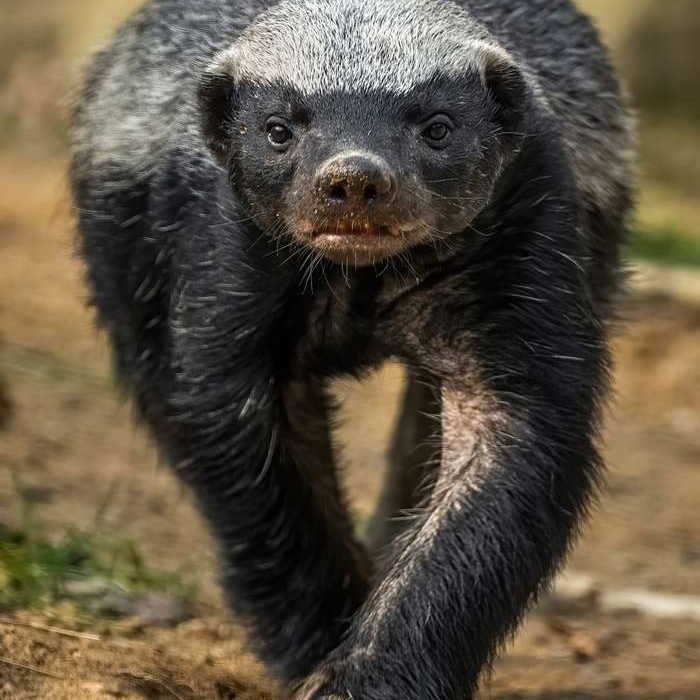Masai Giraffe
( Maasai giraffe or Kilimanjaro giraffe )
- Giraffa camelopardalis tippelskirchi
- IUCN Status: Endangered
- Trend: decreasing

General Information
The Masai giraffe, also called the Kilimanjaro giraffe, is the largest and darkest-colored giraffe subspecies, easily recognized by its jagged, flame-like spots and towering presence. While primarily found in Kenya and Tanzania, small populations extend into eastern Zambia, where they grace the miombo woodlands and savannas.
Description
The Masai giraffe is distinguished by jagged and irregular spots on its body. Its geographic range includes various parts of eastern Africa. It is the largest-bodied giraffe species, making it the tallest land animal on Earth. Bulls are generally larger and heavier than cows.
The Masai giraffe’s most famous feature, its neck, contains seven vertebrae and makes up roughly one third of its body height. Its long and muscular tongue, which can be up to 50 cm in length, is prehensile and allows it to grab leaves from tall trees that are inaccessible to other animals. The tongue’s darker pigment is believed to function as a natural sunscreen and prevent sunburn. On top of the head are two bony structures called ossicones which are covered by thick skin and have dark hair on the tips. These can be used during fights to club its opponent. Bulls usually have an extra ossicone present between the eyes. When galloping, the Masai giraffe has been recorded to reach speeds of almost 64 km per hour.
Fun Facts
The Masai giraffe, also called the Kilimanjaro giraffe, is the largest and darkest-colored giraffe subspecies, easily recognized by its jagged, flame-like spots and towering presence. Their spot patterns are unique like fingerprints—used by researchers for ID.
Ecology & Behaviour
Giraffes are nature’s skilled canopy gardeners, feeding primarily on acacia, combretum, and terminalia leaves high in the treetops—up to 6 meters off the ground. As they browse, they naturally prune branches and disperse seeds, playing a vital role in shaping their ecosystem. To handle their thorny diet, they’ve evolved remarkable adaptations, including a 45 cm prehensile tongue, a tough palate, and thick saliva that shields them from sharp spines.
Highly water-efficient, giraffes rarely need to drink, getting most of their moisture from leaves—though this survival strategy comes with a risk. When they do bend down to drink, they become vulnerable to predators like lions. Their social structure is fluid: females and calves form loose, ever-changing herds, while adult males tend to roam alone or in small bachelor groups.
Male giraffes settle dominance through dramatic necking battles, swinging their powerful necks like wrecking balls and striking with their ossicones (horn-like knobs), sometimes with fatal force. Despite their size, giraffes are mostly silent, communicating through infrasound (too low for humans to hear) and subtle body language—though distressed calves let out a surprisingly cow-like “moo” when in trouble.
Distribution & Habitat
In Zambia they can be found in isolated populations Mostly in eastern Zambia near the Malawi border. Other potential Sightings also include the South Luangwa National park and Lukusuzi National park though uncommon.
Diet
Giraffes are nature’s skilled canopy gardeners, feeding primarily on acacia, combretum, and terminalia leaves high in the treetops—up to 6 meters off the ground. As they browse, they naturally prune branches and disperse seeds, playing a vital role in shaping their ecosystem. To handle their thorny diet, they’ve evolved remarkable adaptations, including a 45 cm prehensile tongue, a tough palate, and thick saliva that shields them from sharp spines.
Highly water-efficient, giraffes rarely need to drink, getting most of their moisture from leaves—though this survival strategy comes with a risk. When they do bend down to drink, they become vulnerable to predators like lions. Their social structure is fluid: females and calves form loose, ever-changing herds, while adult males tend to roam alone or in small bachelor groups.
Male giraffes settle dominance through dramatic necking battles, swinging their powerful necks like wrecking balls and striking with their ossicones (horn-like knobs), sometimes with fatal force. Despite their size, giraffes are mostly silent, communicating through infrasound (too low for humans to hear) and subtle body language—though distressed calves let out a surprisingly cow-like “moo” when in trouble.
Reproduction
Giraffes are nature’s skilled canopy gardeners, feeding primarily on acacia, combretum, and terminalia leaves high in the treetops—up to 6 meters off the ground. As they browse, they naturally prune branches and disperse seeds, playing a vital role in shaping their ecosystem. To handle their thorny diet, they’ve evolved remarkable adaptations, including a 45 cm prehensile tongue, a tough palate, and thick saliva that shields them from sharp spines.
Highly water-efficient, giraffes rarely need to drink, getting most of their moisture from leaves—though this survival strategy comes with a risk. When they do bend down to drink, they become vulnerable to predators like lions. Their social structure is fluid: females and calves form loose, ever-changing herds, while adult males tend to roam alone or in small bachelor groups.
Male giraffes settle dominance through dramatic necking battles, swinging their powerful necks like wrecking balls and striking with their ossicones (horn-like knobs), sometimes with fatal force. Despite their size, giraffes are mostly silent, communicating through infrasound (too low for humans to hear) and subtle body language—though distressed calves let out a surprisingly cow-like “moo” when in trouble.
Conservation
Masai giraffes are considered endangered by the IUCN, and the Masai giraffe population declined 52% in recent decades due to poaching and habitat loss. The population amounts to 32,550 in the wild.
Masai giraffes can suffer from giraffe skin disease, which is a disorder of unknown etiology that causes lesion on the forelimbs. This disorder is being further investigated to better understand mortality in this species.
References
Share:
- Kingdom: Animalia
- Phylum: Chordata
- Class: Mammalia
- Order: Artiodactyla
- Family: Giraffidae
- Genus: Giraffa
- Shoulder height: up to 5.5 m
- Weight: avg. 1300kg
- Lifespan: avg. 30 yrs












